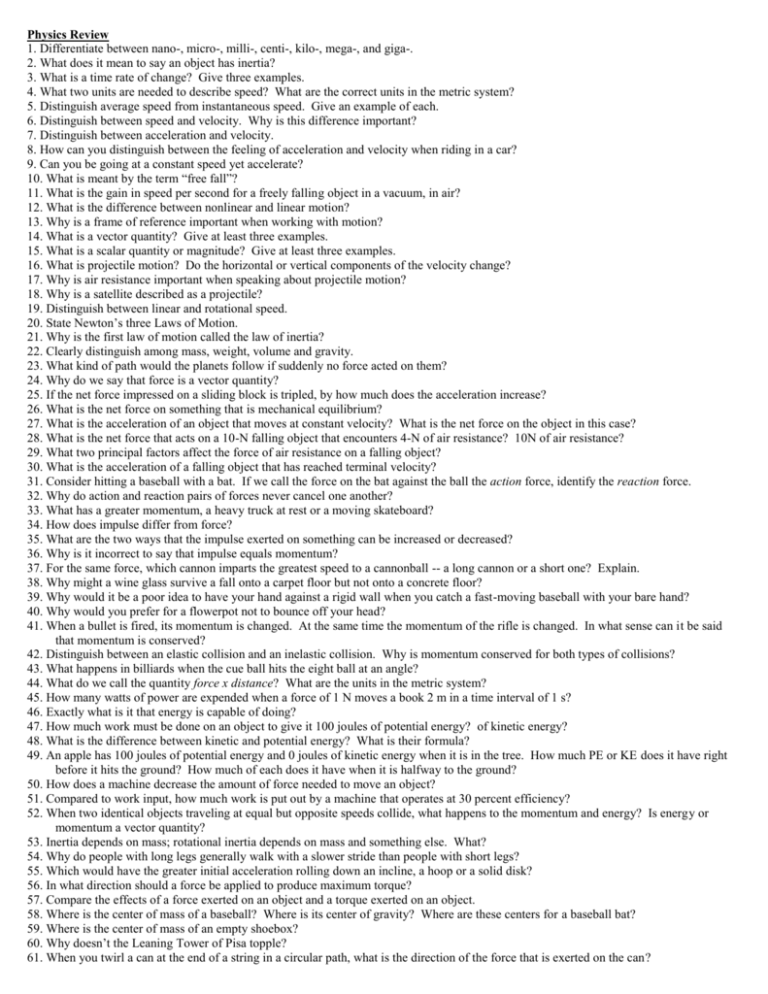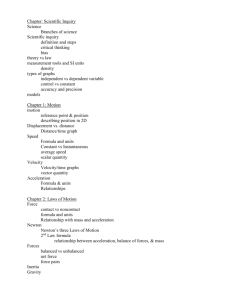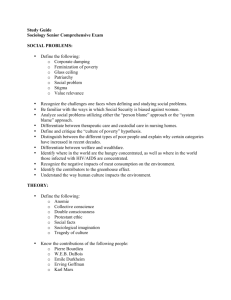Physics Review Questions
advertisement

Physics Review 1. Differentiate between nano-, micro-, milli-, centi-, kilo-, mega-, and giga-. 2. What does it mean to say an object has inertia? 3. What is a time rate of change? Give three examples. 4. What two units are needed to describe speed? What are the correct units in the metric system? 5. Distinguish average speed from instantaneous speed. Give an example of each. 6. Distinguish between speed and velocity. Why is this difference important? 7. Distinguish between acceleration and velocity. 8. How can you distinguish between the feeling of acceleration and velocity when riding in a car? 9. Can you be going at a constant speed yet accelerate? 10. What is meant by the term “free fall”? 11. What is the gain in speed per second for a freely falling object in a vacuum, in air? 12. What is the difference between nonlinear and linear motion? 13. Why is a frame of reference important when working with motion? 14. What is a vector quantity? Give at least three examples. 15. What is a scalar quantity or magnitude? Give at least three examples. 16. What is projectile motion? Do the horizontal or vertical components of the velocity change? 17. Why is air resistance important when speaking about projectile motion? 18. Why is a satellite described as a projectile? 19. Distinguish between linear and rotational speed. 20. State Newton’s three Laws of Motion. 21. Why is the first law of motion called the law of inertia? 22. Clearly distinguish among mass, weight, volume and gravity. 23. What kind of path would the planets follow if suddenly no force acted on them? 24. Why do we say that force is a vector quantity? 25. If the net force impressed on a sliding block is tripled, by how much does the acceleration increase? 26. What is the net force on something that is mechanical equilibrium? 27. What is the acceleration of an object that moves at constant velocity? What is the net force on the object in this case? 28. What is the net force that acts on a 10-N falling object that encounters 4-N of air resistance? 10N of air resistance? 29. What two principal factors affect the force of air resistance on a falling object? 30. What is the acceleration of a falling object that has reached terminal velocity? 31. Consider hitting a baseball with a bat. If we call the force on the bat against the ball the action force, identify the reaction force. 32. Why do action and reaction pairs of forces never cancel one another? 33. What has a greater momentum, a heavy truck at rest or a moving skateboard? 34. How does impulse differ from force? 35. What are the two ways that the impulse exerted on something can be increased or decreased? 36. Why is it incorrect to say that impulse equals momentum? 37. For the same force, which cannon imparts the greatest speed to a cannonball -- a long cannon or a short one? Explain. 38. Why might a wine glass survive a fall onto a carpet floor but not onto a concrete floor? 39. Why would it be a poor idea to have your hand against a rigid wall when you catch a fast-moving baseball with your bare hand? 40. Why would you prefer for a flowerpot not to bounce off your head? 41. When a bullet is fired, its momentum is changed. At the same time the momentum of the rifle is changed. In what sense can it be said that momentum is conserved? 42. Distinguish between an elastic collision and an inelastic collision. Why is momentum conserved for both types of collisions? 43. What happens in billiards when the cue ball hits the eight ball at an angle? 44. What do we call the quantity force x distance? What are the units in the metric system? 45. How many watts of power are expended when a force of 1 N moves a book 2 m in a time interval of 1 s? 46. Exactly what is it that energy is capable of doing? 47. How much work must be done on an object to give it 100 joules of potential energy? of kinetic energy? 48. What is the difference between kinetic and potential energy? What is their formula? 49. An apple has 100 joules of potential energy and 0 joules of kinetic energy when it is in the tree. How much PE or KE does it have right before it hits the ground? How much of each does it have when it is halfway to the ground? 50. How does a machine decrease the amount of force needed to move an object? 51. Compared to work input, how much work is put out by a machine that operates at 30 percent efficiency? 52. When two identical objects traveling at equal but opposite speeds collide, what happens to the momentum and energy? Is energy or momentum a vector quantity? 53. Inertia depends on mass; rotational inertia depends on mass and something else. What? 54. Why do people with long legs generally walk with a slower stride than people with short legs? 55. Which would have the greater initial acceleration rolling down an incline, a hoop or a solid disk? 56. In what direction should a force be applied to produce maximum torque? 57. Compare the effects of a force exerted on an object and a torque exerted on an object. 58. Where is the center of mass of a baseball? Where is its center of gravity? Where are these centers for a baseball bat? 59. Where is the center of mass of an empty shoebox? 60. Why doesn’t the Leaning Tower of Pisa topple? 61. When you twirl a can at the end of a string in a circular path, what is the direction of the force that is exerted on the can? 62. Differentiate between centripetal and centrifugal force. 63. How can gravity be simulated in an orbiting space station? What are the effects of speeding up the rotation of the space station on an astronaut on the inside and one on the outside? 64. How will the value of g vary at different distances from the hub of a rotating space station? 65. Distinguish between linear and angular speed. Distinguish between linear momentum and angular momentum. 66. Does a cat defy the law of conservation of angular momentum? Explain how it always lands on its feet. 67. Describe the periods of a pendulum of different lengths. Relate this to rotational inertia. 68. Define the following terms related to wave motion: oscillation, amplitude, frequency, period, wavelength, wave speed, and sine wave. 69. Describe the motion of a wave using the preceding terms. 70. Explain or derive the wave speed = frequency x wavelength formula. Describe what influences 71. Describe the similarities and differences between transverse and longitudinal waves. Describe compression and rarefaction. 72. Explain interference, beginning with water waves and then apply your knowledge to standing waves. 73. Describe the Doppler effect, wave barriers, bow waves and shock waves. Describe what happens as the speed of the vehicle increases beyond the speed of sound. 74. Describe the origin of all sound and all wave motion. 75. List and describe the factors that affect the nature of sound in air. 76. Discuss the speed of sound through different media. 77. Discuss the speed of sound and how one can estimate the distance from a lightning storm. 78. Describe how to increase or decrease echoes. What uses exist for echoes in nature and by man? 79. Describe what is meant by refraction of sound. What uses exist for refraction in nature and by man? 80. Differentiate between forced vibrations and natural frequency. 81. Describe resonance. 82. Describe interference and superposition of waves. 83. Describe the difference between noise and music. 84. Decibels are a measure of what? 85. Define and describe pitch, loudness and quality. 86. Describe how musical instruments work. Differentiate between an open and closed organ. Describe how string instruments work. 87. Discuss Fourier analysis and the superposition of waves. 88. Describe how CD's work. 89. Compare the strength of electrical force to gravitational force. Indicate some similarities with the formulas. 90. Indicate what causes electrical charge. Explain what happens to normally neutral substances due to rubbing. 91. Explain conservation of charge. 92. Differentiate between charging by induction and by contact. 93. Describe shielding 94. Illustrate electric field lines and equipotential lines. 95. Describe how and why lightning occurs. Why are lightning rods pointed? 96. Describe how a Van de Graaff generator works. 97. Describe electric potential energy, electric potential and volts. 98. Describe the flow of charge or electric current. 99. Relate voltage to the idea of electrical pressure. 100. Discuss the function of the third prong on electric plugs and why it is longer than the pair of flat prongs. 101. Discuss electric shock and why electricians put one hand behind their back when probing questionable circuits. 102. Describe the four things important for electrical resistance. 103. Define and describe Ohm's Law. 104. Differentiate between AC and DC current. 105. Describe the speed of electrons and energy in a circuit. Differentiate between AC and DC circuits. 106. Distinguish between electrical energy and power. 107. Describe the rules for series and parallel circuits 108. Make up a series circuit and a parallel circuit. Describe how you would determine the power used by each resistor. 109. Describe the location of the fuses or circuit breakers in a circuit. 110. Describe why only certain pieces of iron will act as magnets. 111. Pure nickel is attracted to a magnet. Why aren't today's nickels? 112. Discuss the poles of a magnet and how attraction and repulsion works. 113. Show the magnetic field configurations about a bar magnet. 114. Explain magnetic induction and how bringing a non-magnetized nail near a magnet induces it to become a magnet. 115. Discuss the source of all magnetism -- the motion of electrons. 116. Describe how electromagnets are formed and what determines its strength. 117. Discuss how Superman the Ride works or how magnetically levitated super trains works. 118. Describe the effect of magnets on current-carrying wires. Define the right-hand rule. 119. Discuss the magnetic field configuration around the earth and how the magnetic field lines deflect cosmic rays. 120. Discuss the evidence for the theory that the earth's magnetic pole undergoes reversal. 121. How can you begin with electricity and produce magnetism or how can you begin with magnetism and produce electricity? 122. Differentiate between generators and motors. Describe how generators can be used to make DC or AC power. 123. Describe the importance of transformers for power transmission. Describe how a transformer works. 124. Describe the transmission of electromagnetic waves. 125. What is produced when you shake a charge rod back and forth in free space? 126. What is the velocity of EM? 127. What are the spectrums within the EM? 128. Differentiate between transparent and opaque materials. Is an object always transparent or opaque? 129. Differentiate between diffuse and sharp shadows. 130. Describe the mechanism of sight. 131. Differentiate between selective transmission and reflection. Give examples of each. 132. Describe the difference between mixing color light and pigments. 133. Why is the sky blue, the ocean cyan, clouds are white, and sunsets are red? 134. Describe the principle of least time. 135. Define the law of reflection. Describe how it works with plane and curved mirrors. 136. Define refraction and its importance. 137. Describe the cause of refraction. 138. Describe how a rainbow is produced. 139. Define and describe total internal refraction. 140. Describe fiber optics. 141. Explain and show how to determine the image location for mirrors and lenses. 142. How can you determine the focal point for convex and concave lenses and mirrors?







